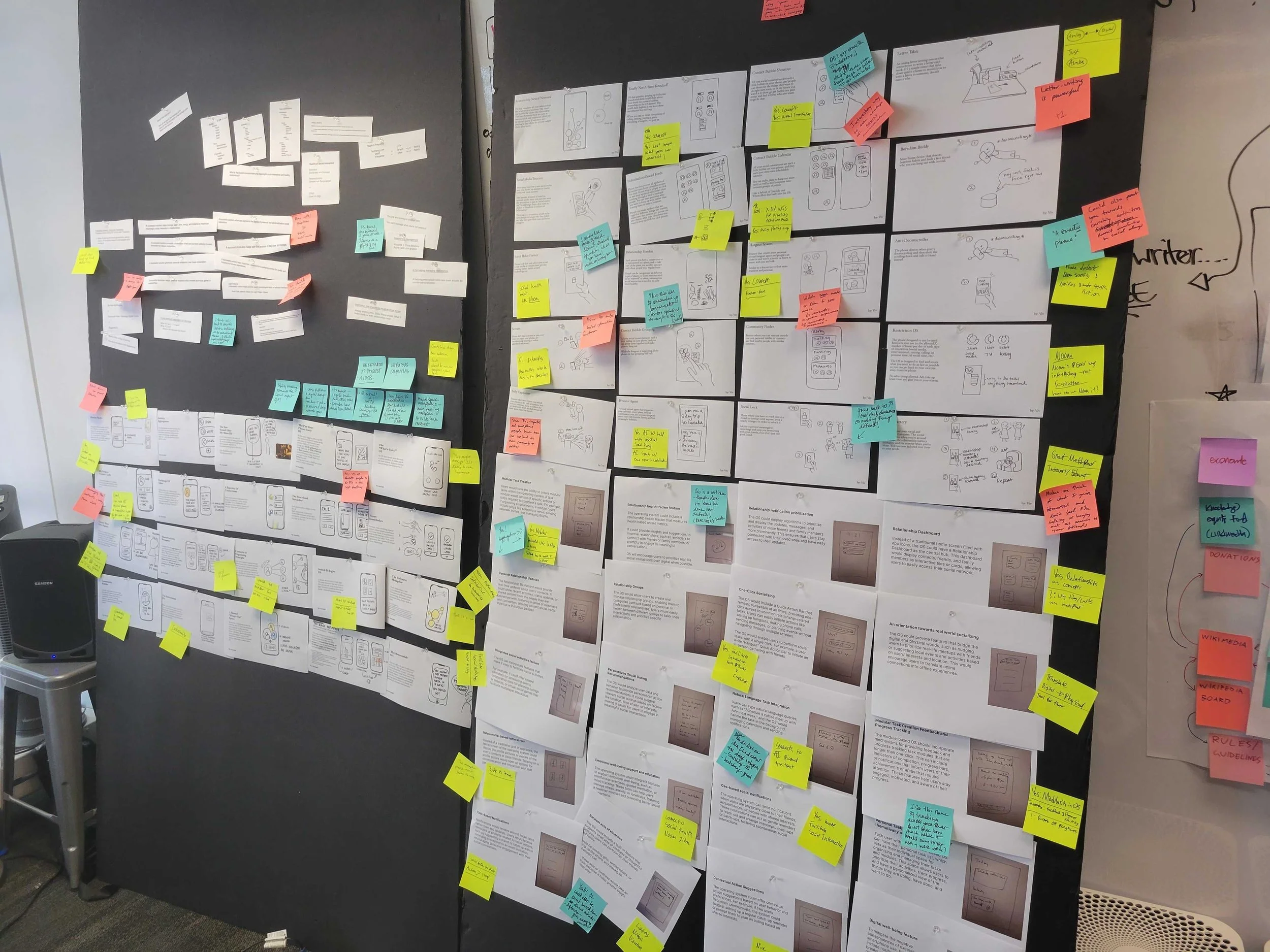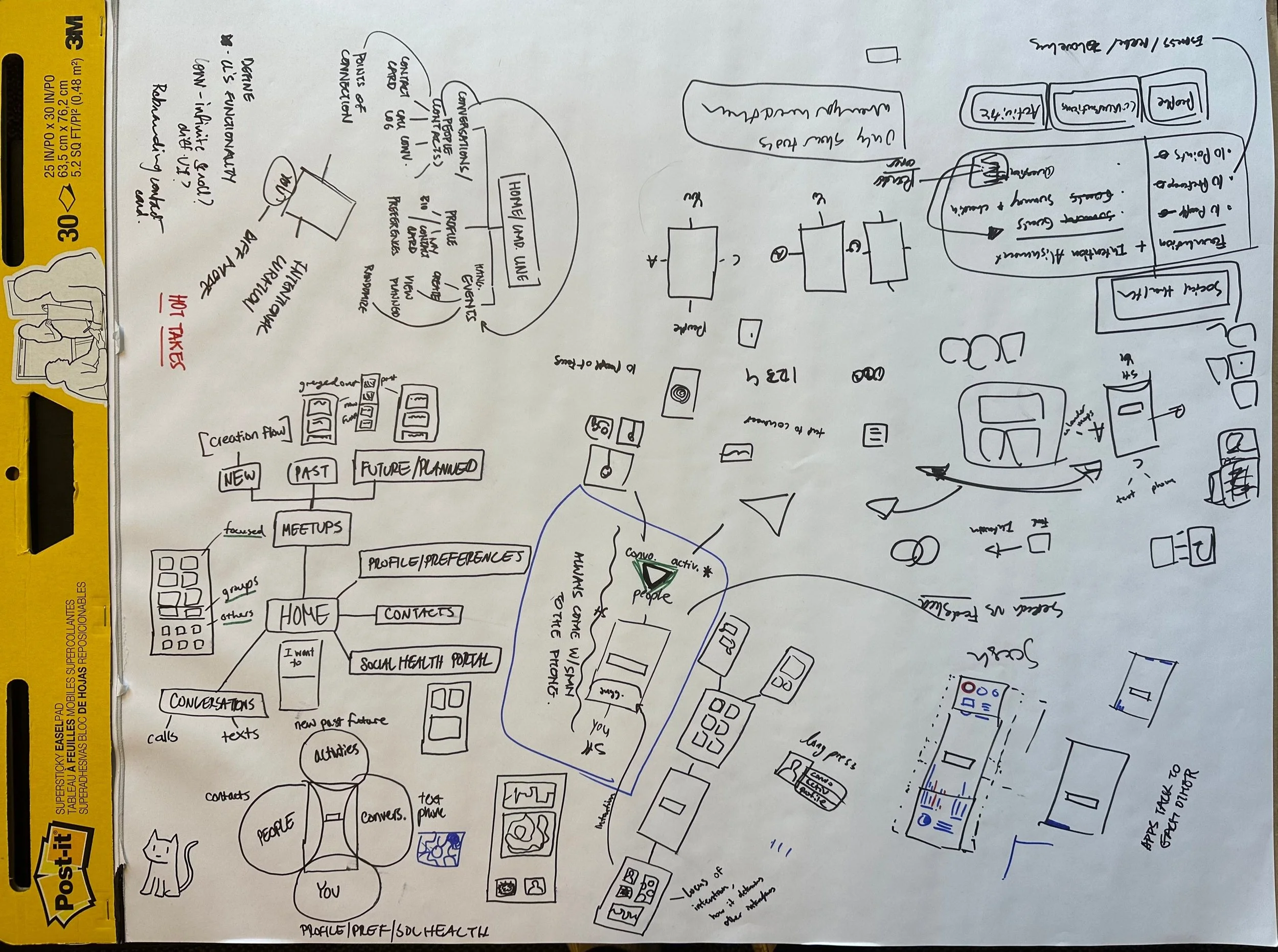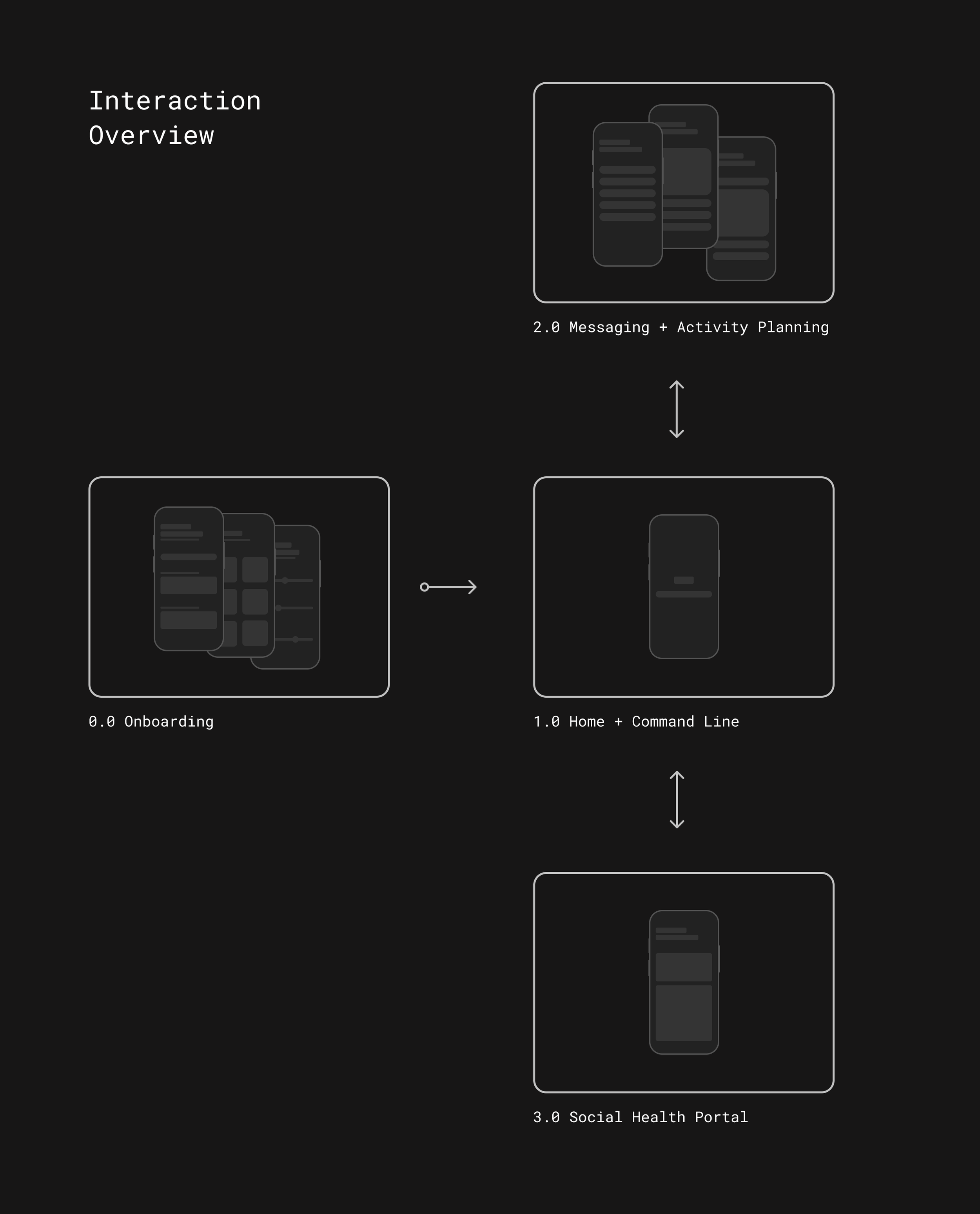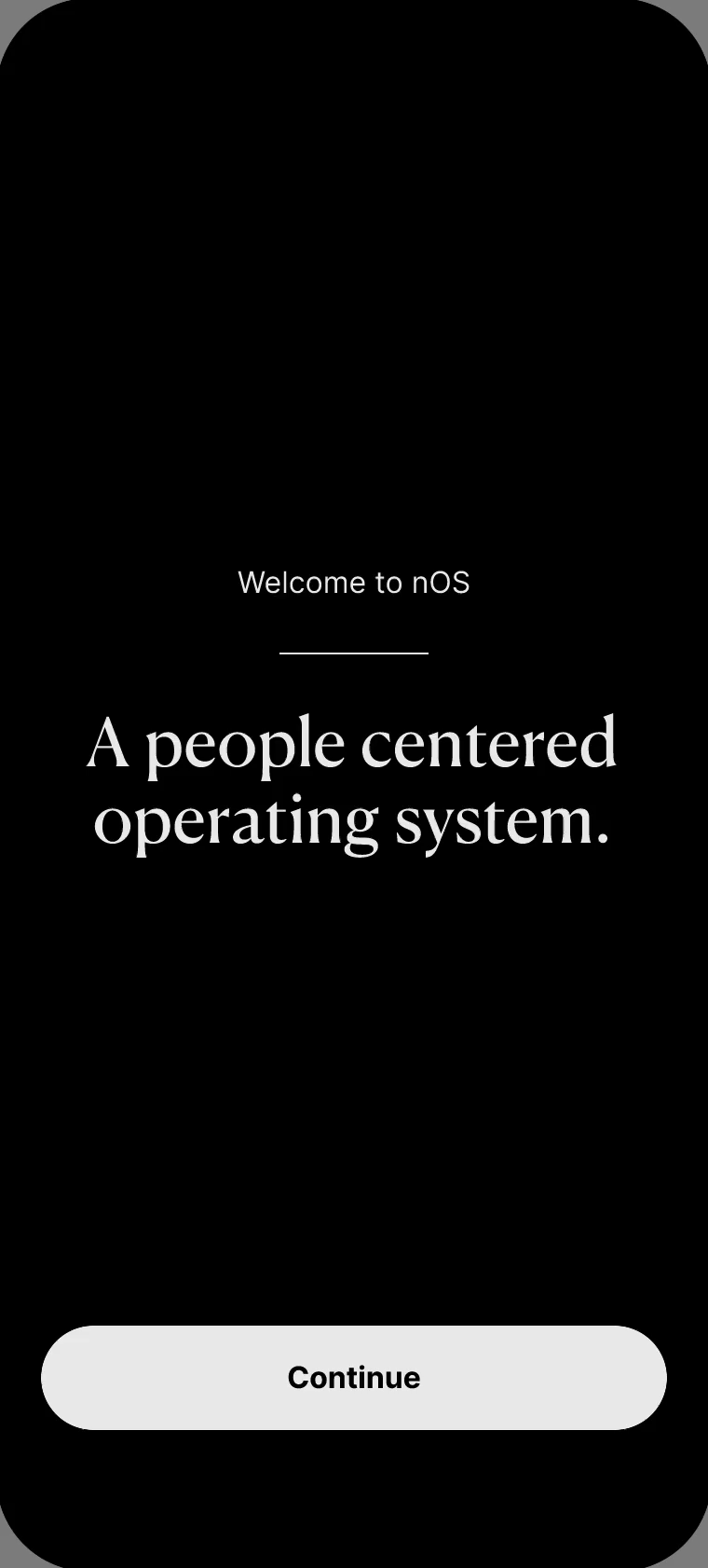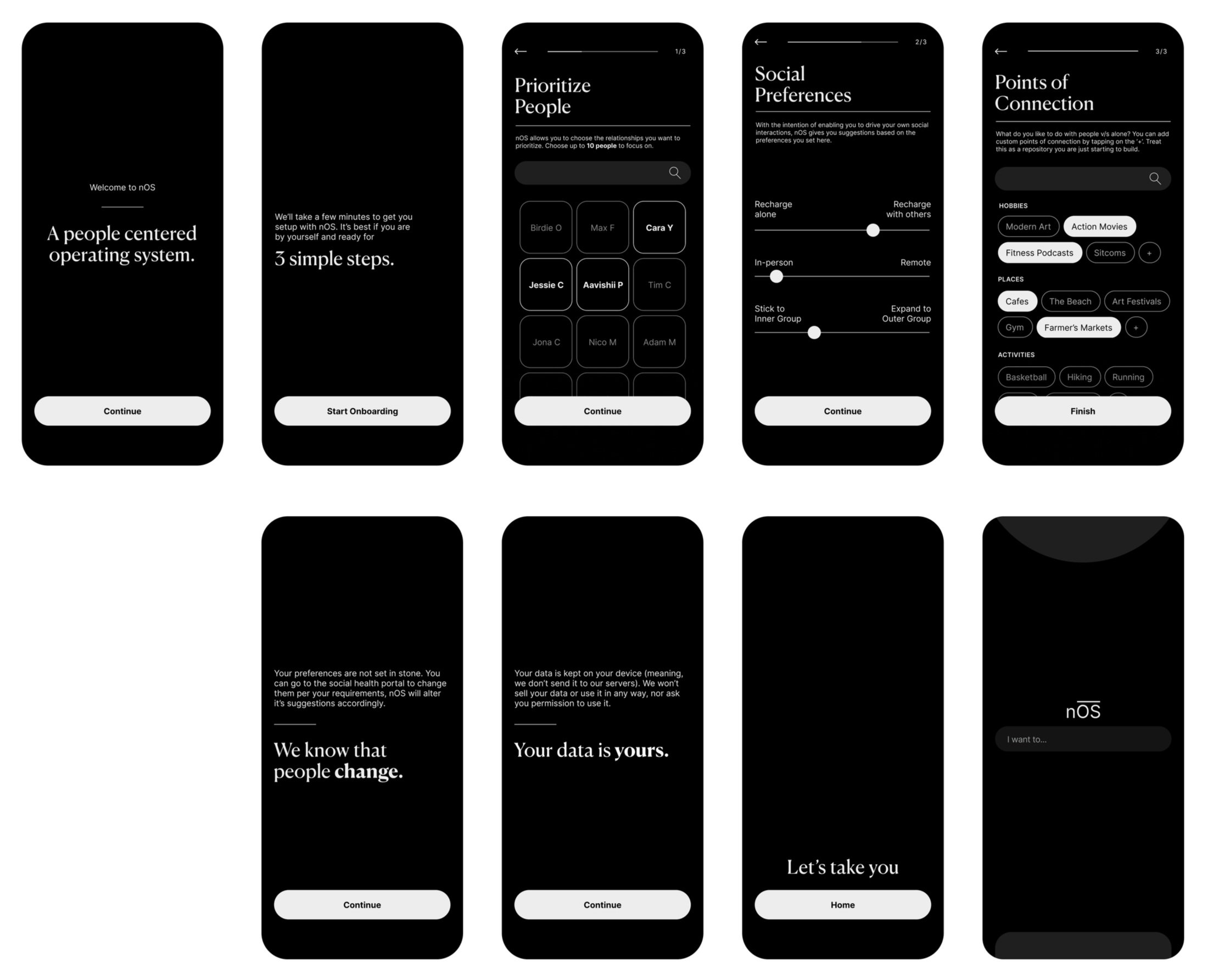
nOS: A Speculative Mobile OS
The ‘attention economy’ treats human attention as a valuable commodity. Significant fortunes have been amassed by capturing human attention and data and subsequently selling these assets to advertisers. Companies engage in a relentless battle to attract and retain users' gaze on screen, and they have skillfully exploited our innate biological inclinations to care about elements like safety, social status, belonging, reciprocity, and justice—using them to craft captivating and highly addictive digital experiences.
However, this unwavering pursuit of expertly crafted ‘sticky’ experiences has caused smartphones to become barriers to social connection. The world is lonelier than ever, and we are in dire need of technology that prioritizes meaningful social connection over mindless consumption. Many of us struggle to maintain meaningful relationships, leading to adverse effects on our well-being. In response, I embarked on a speculative design journey to reimagine the conventional mobile operating system.
The outcome is nOS — a speculative vision of a mobile operating system that places people, conversations, and activities at its core. It harnesses the modern capabilities of technology to nurture our most valued relationships and promote the flourishing of our social health.
Organization
Building H
Project Duration
6 months
Team
MHCI+D Grad students
Role
UX/UI Design Lead, Design Research
Inspiration
“Imagine if instead of apps, our smartphones were built around the relationships we care about—if, instead of opening an app to connect with who we love, we simply remained connected with those we loved, and the tools to bring us closer appeared only when we needed them, in the flow of our relationships with one another. Who knows how much easier, how much more satisfying, our digital lives might be if the governing metaphor for smartphones were one of human connection, rather than programs. ”
Research
Research Questions
1. What would an ideal social life look like for young adults?
2. How do young adults individually experience, identify, and address loneliness, if at all? (When, where, and what tools)
3. How do young adults start, grow, and maintain their relationships?
Literature Review - Takeaways
🧓 22% of all adults in the US say they often or always feel lonely or socially isolated - Henry J. Kaiser Family Foundation, 2018.
📈 79% of adults aged 18-24 reported experiencing loneliness - Cigna Health Insurance, 2020.
🧒 Young adults aged 18-22 reported the highest levels of loneliness - Cigna Health Insurance, 2018.
🚬 The impact of lacking social connection on reducing life span is equivalent to the risk of smoking 15 cigarettes a day - Dr. Cacioppo, n.d.
Research Methodology
📔 Diary Study
🎙️ Semi-structured Interview
I analysed data from two week-long diary studies and used the data to inform two follow up 60-minute semi-structured interviews that I conducted.
Discoveries
The Challenge
How might we change the governing metaphor used in mobile operating systems from apps to relationships to help improve the social health of users and ultimately help address the loneliness epidemic?
Design
Outcomes
Design
Principles
Overall, we wanted a solution that:
✅ Is delightful and usage leaves users with a sense of well-being
✅ Facilitates meaningful relationships
✅ Maintains smartphone capabilities (e.g. internet search)
We wanted to avoid:
🚫 Creating ‘sticky’ experiences that enable technology addiction
🚫 Basing the mobile interface on the organizing principle of apps
🚫 Distracting or overly stimulating information or visual displays
-
Guides user behaviors towards healthier social habits and facilitates relationship management.
-
Educates users about the principles behind social health so they can make more informed decisions.
-
Streamlines the social planning process to allow for more time spent in meaningful social interaction.
-
All data is stored locally on the device and users have complete discretion as to how to use and share their personal data.
Ideation
Storyboarding
Collating our Ideas and Downselecting
After ideating over 100 potential solutions, we downselected and combined ideas we thought were most promising by soliciting team feedback through post-it notes.
Our team blackboard with all of our ideas collated — featuring post-it note comments.
Narrative Experimentation and Feature Selection
Applying McCloud's 5 choices storyboarding framework, we experimented with several key elements.
Time Frames, such as "A Day in the Life" versus "A Week in the Life," were explored to determine their impact on pacing and character development.
Additionally, I delved into Continuous and Discrete Scene Flows, understanding how they can affect narrative engagement and emotional resonance.
Our first iteration storyboard featuring 3 distinct scenes.
Our revised storyboard - albeit with lower production quality - featuring revised phone interactions
Early Concept
Explorations
Frameworks
From Abstract to Concrete
Prior to and throughout the early design exploration process, we faced a significant challenge in translating our abstract concepts into tangible representations. This complexity stemmed from the inherently abstract nature of the problem domain we were addressing.
To tackle this issue effectively, we leveraging whiteboards and large sheets of paper as a collaborative tool. This allowed us to visually map out the most pertinent frameworks and product features that needed to be at the forefront of our design considerations.
The whiteboard during this stage of the project - our goal being to change the user’s conceptual model of the phone
A group brainstorm - sketching different ways to map the information architecture of the mobile OS
Social Health as the center of a Mobile OS
The diagram provided below illustrates the innovative organizational framework of nOS.
In contrast to conventional app-based interfaces, nOS takes a unique approach by structuring the mobile interface around the central concept of relationships.
nOS breaks down relationships into People, Conversations, and Activities: People, representing those with whom you engage, and then subdivided into Conversations, encompassing text messages or phone calls initiated on the device, and Activities, signifying in-person gatherings and shared experiences among individuals.
Furthermore, during the development of nOS, our team established a comprehensive social health framework to effectively anchor the platform in social health. This framework comprises two integral elements.
First, the Individual Foundation, which is tailored to each user individually and is established during the onboarding process. It serves as a unique baseline that reflects the user's personality and social life.
Second, the Intention Alignment, which delineates the characteristics and functions of the social health portal. This portal is instrumental in helping users stay in sync with their self-defined social health objectives.
Interaction
Design
Three Key User Flows in the Mobile OS
Our final design contains three distinct user flows: the initial onboarding flow, an activity scheduling flow, and the social health portal.
The activity scheduling flow is accessed through a swipe down on the home screen and the social health portal is accessed through a swipe up from the home screen.
Final Designs
Onboarding Flow
Social health is unique to each and every individual.
Therefore, nOS helps align users with their ideal social health in three ways:
Defining who in their life users want to focus on
Understanding their own preferences for socializing
Identifying the common interests users share with those that matter most to them — these points of connection are used to generate activity and conversation suggestions
Activity Scheduling Flow
Life can be busy. So much so, that when we set a genuine intention to hangout, the business of life can often get in the way of coordinating those plans. Throughout our research, it was clear that planning activities with (multiple) friends was a major sticking point.
Imagine using your phone to seamlessly plan an activity with your friends, without the hassle of manually coordinating the time and place over text.
How? Start by choosing who to invite, then choosing the activity, time, and location. nOS suggests times where you are all available and activities that you all enjoy, leaving the guesswork out of making plans.
Social Health Portal
In the social health portal, nOS presents users with a reflection question every week to empower them with new perspectives that encourage them to thoughtfully contemplate their social health.
People aren’t often aware of or think about their social health, even though it is as important as our physical and mental health.
By keeping your most meaningful relationships front-and-center, nOS will nudge you (unobtrusively) to nurture the connections you want to maintain and grow.









